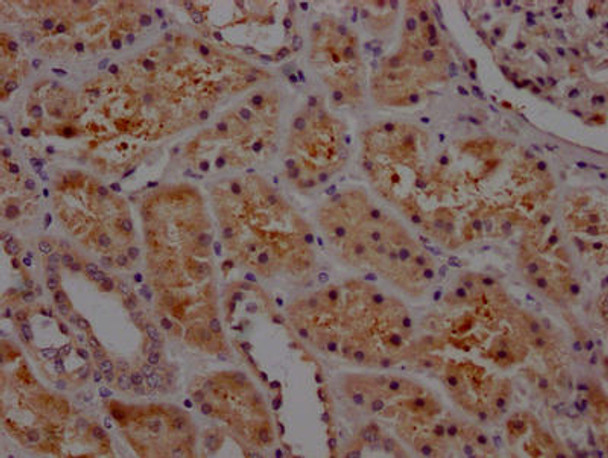Anti-SERPINE1 Antibody (RACO0525)
- SKU:
- RACO0525
- Product type:
- Recombinant Antibody
- Reactivity:
- Human
- Host Species:
- Human
- Isotype:
- IgG
- Application:
- WB
- Application:
- ELISA
- Application:
- IHC
- Conjugation:
- Unconjugated
Description
| 商品名: | SERPINE1 Antibody |
| Product SKU: | RACO0525 |
| サイズ: | 50ul |
| 宿主種: | Homo sapiens (Human) |
| 申し込み: | ELISA, WB, IHC |
| 推奨される希釈: | WB:1:500-1:5000, IHC:1:50-1:200 |
| 反応性: | Human |
| 免疫原: | A synthesized peptide derived from human PAI1 |
| 憲法: | Liquid |
| ストレージバッファ: | Rabbit IgG in phosphate buffered saline, pH 7.4, 150mM NaCl, 0.02% sodium azide and 50% glycerol. |
| 精製方法: | Affinity-chromatography |
| 抗体のクローン性: | Monoclonal |
| アイソタイプ: | Rabbit IgG |
| Conjugate: | Non-conjugated |
| バックグラウンド: | Serine protease inhibitor. This inhibitor acts as 'bait' for tissue plasminogen activator, urokinase, protein C and matriptase-3/TMPRSS7. Its rapid interaction with PLAT may function as a major control point in the regulation of fibrinolysis. |
| シノニム: | Plasminogen activator inhibitor 1 (PAI) (PAI-1) (Endothelial plasminogen activator inhibitor) (Serpin E1), SERPINE1, PAI1 PLANH1 |
 | IHC image of RACO0525 diluted at 1:100 and staining in paraffin-embedded human kidney tissue performed on a Leica BondTM system. After dewaxing and hydration, antigen retrieval was mediated by high pressure in a citrate buffer (pH 6.0). Section was blocked with 10% normal goat serum 30min at RT. Then primary antibody (1% BSA) was incubated at 4°C overnight. The primary is detected by a Goat anti-rabbit IgG polymer labeled by HRP and visualized using 0.05% DAB. |
 | Western Blot. Positive WB detected in U-251 whole cell lysate U-87 whole cell lysate All lanes PAI1 Antibody at 1:1000. Secondary. Goat polyclonal to rabbit IgG at 1:50000 dilution. Predicted band size: 46, 44 kDa. Observed band size: 45 kDa. |
| UniProt Protein Function: | SERPINE1: a secreted protein that acts as 'bait' for tissue plasminogen activator, urokinase, and protein C. Its rapid interaction with TPA may function as a major control point in the regulation of fibrinolysis. Belongs to the serpin family. Interacts with VTN. Binds LRP1B; binding is followed by internalization and degradation. Plasma levels of PAI-1 and VCAM-1 together may be useful in predicting post-operative recurrence in patients with colorectal cancer. |
| UniProt Protein Details: | Protein type:Secreted, signal peptide; Motility/polarity/chemotaxis; Secreted Chromosomal Location of Human Ortholog: 7q22.1 Cellular Component: extracellular matrix; extracellular space; extracellular region; plasma membrane Molecular Function:serine-type endopeptidase inhibitor activity; protein binding; protease binding; receptor binding Biological Process: circadian rhythm; transcription initiation from RNA polymerase II promoter; platelet activation; extracellular matrix organization and biogenesis; positive regulation of blood coagulation; transcription, DNA-dependent; negative regulation of blood coagulation; negative regulation of smooth muscle cell migration; defense response to Gram-negative bacterium; positive regulation of receptor-mediated endocytosis; regulation of cell proliferation; positive regulation of interleukin-8 production; fibrinolysis; positive regulation of angiogenesis; platelet degranulation; negative regulation of fibrinolysis; transforming growth factor beta receptor signaling pathway; gene expression; positive regulation of transcription from RNA polymerase II promoter; regulation of receptor activity; angiogenesis; chronological cell aging; blood coagulation; negative regulation of cell adhesion mediated by integrin; negative regulation of cell migration; positive regulation of inflammatory response Disease: Plasminogen Activator Inhibitor-1 Deficiency |
| NCBI Summary: | This gene encodes a member of the serine proteinase inhibitor (serpin) superfamily. This member is the principal inhibitor of tissue plasminogen activator (tPA) and urokinase (uPA), and hence is an inhibitor of fibrinolysis. Defects in this gene are the cause of plasminogen activator inhibitor-1 deficiency (PAI-1 deficiency), and high concentrations of the gene product are associated with thrombophilia. Alternatively spliced transcript variants encoding different isoforms have been found for this gene. [provided by RefSeq, Sep 2009] |
| UniProt Code: | P05121 |
| NCBI GenInfo Identifier: | 129576 |
| NCBI Gene ID: | 5054 |
| NCBI Accession: | P05121.1 |
| UniProt Secondary Accession: | P05121,B7Z4S0, F8WD53, |
| UniProt Related Accession: | P05121 |
| Molecular Weight: | 43,404 Da |
| NCBI Full Name: | Plasminogen activator inhibitor 1 |
| NCBI Synonym Full Names: | serpin peptidase inhibitor, clade E (nexin, plasminogen activator inhibitor type 1), member 1 |
| NCBI Official Symbol: | SERPINE1 |
| NCBI Official Synonym Symbols: | PAI; PAI1; PAI-1; PLANH1 |
| NCBI Protein Information: | plasminogen activator inhibitor 1; serpin E1; endothelial plasminogen activator inhibitor; serine (or cysteine) proteinase inhibitor, clade E (nexin, plasminogen activator inhibitor type 1), member 1 |
| UniProt Protein Name: | Plasminogen activator inhibitor 1 |
| UniProt Synonym Protein Names: | Endothelial plasminogen activator inhibitor; Serpin E1 |
| UniProt Gene Name: | SERPINE1 |
| UniProt Entry Name: | PAI1_HUMAN |

